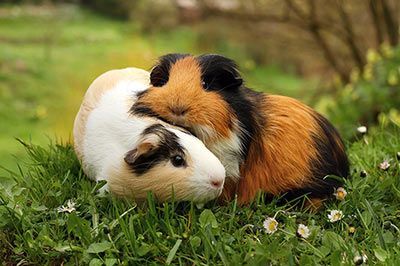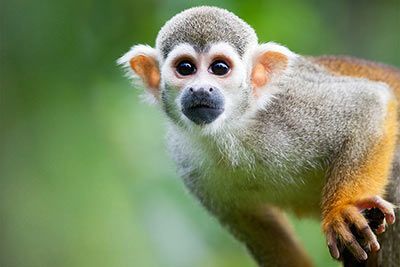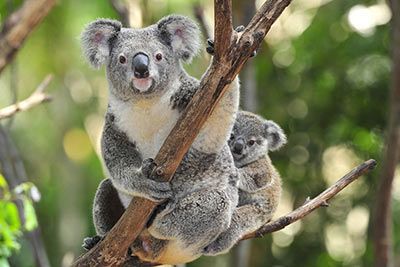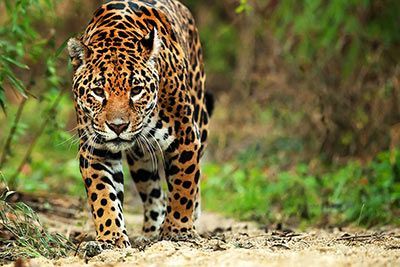Tree Kangaroo
Tree Kangaroo Facts
| Size | 18-35 inches (50-80 cm) (body) |
| Speed | Up to 5 mph (30 km/h) |
| Weight | 13-33 pounds (5.9-18 kg) |
| Lifespan | 15-20 years |
| Food | Leaves, fruit, nuts, bark |
| Predators | Pythons, dingoes |
| Habitat | Australia, New Guinea |
| Order | Diprotodontia |
| Family | Kangaroos |
| Scientific name | Dendrolagus |
| Characteristics | Only kangaroo species that lives in trees |
Main Characteristics
Tree kangaroos are the only kangaroos that live in trees. Their most striking features are their large paws, long, curved claws and long tail. While ground-dwelling kangaroos hop on their two hind legs, tree kangaroos can walk on all fours and move their legs independently. The majority of tree kangaroo species are classified as endangered. The biggest threats to them are hunting and habitat loss.
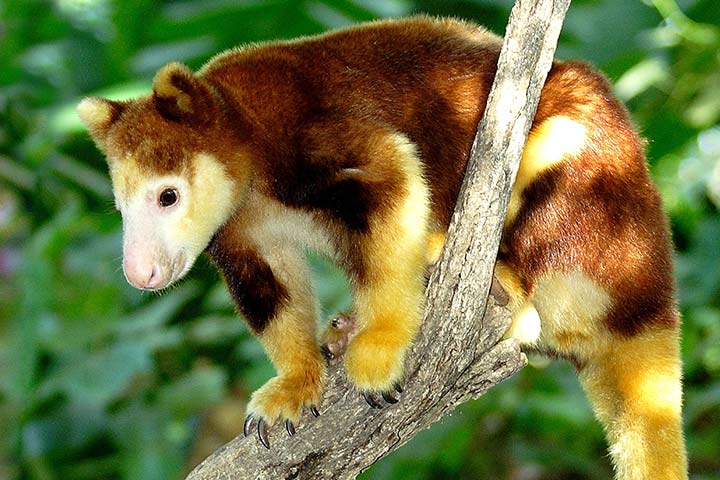
Species
There are 14 species of tree kangaroos. The best known is the Matschie tree kangaroo. Lumholtz's tree-kangaroo, Bennett's tree-kangaroo and Tenkile.
Distribution and Habitat
Tree kangaroos live in northeastern Australia and New Guinea. Their natural habitat is tropical rainforests, mostly in higher, mountainous regions.

Life Style
Tree kangaroos are solitary animals. Most are active at night and at dusk. During the day they rest and at night they go looking for food. They spend over 90% of their lives in trees and rarely climb down to the ground. Most of the time they stay at a height of 18-20 m and jump from tree to tree.
Temperament
Are tree kangaroos as cute and friendly as they look? If a male invades another's territory, a fight can break out. Apart from that, the marsupials are rather calm and good-natured. Unfortunately, this is exactly what becomes their downfall when they meet people - they allow themselves to be caught by hunters without much resistance.

Anatomy and Appearance
Size and Weight
Tree kangaroos have a body length of 18-35 inches (48-91 cm) and a weight of 13-33 pounds (5.9-15 kg). The smallest is the Lumholtz tree kangaroo. It grows 48-65 cm tall and weighs 13-16 pounds (5.9-7.2 kg). The largest is the grizzled tree kangaroo. It can grow up to 35 inches (91 cm) tall and weigh up to 33 pounds (15 kg).
Arms and Legs
Kangaroos that live on the ground have very short arms and very long legs. Things are different with tree kangaroos. Arms and legs are about the same length.
Fur
Thick and insulating, the fur of tree kangaroos comes in a range of colors including black, gray, brown, or beige, and can feature lovely patterns.
Tail
Tree kangaroos have a very long tail. It is 20-35 inches (50-90 cm) long, which is about the same length as their body. Unlike their terrestrial relatives, their tail maintains a consistent thickness throughout instead of tapering to a narrow point at the end.
Ears
Unlike other kangaroos, tree kangaroos have very short ears.

Diet
Tree kangaroos feed almost exclusively on leaves. They occasionally eat fruits, nuts, tree sap and bark. They also sometimes eat insects and bird eggs.
Behavior
Sleeping
Tree kangaroos spend about 60% of their time sleeping. However, they do not build a nest like orangutans, but simply look for a comfortable, horizontal branch on which they lie down and take long naps.
Sweating
Tree kangaroos have a unique method of cooling down. Instead of sweating, they lick their arms with their tongues when they get too hot. This helps to cool their skin as the moisture evaporates from their fur.
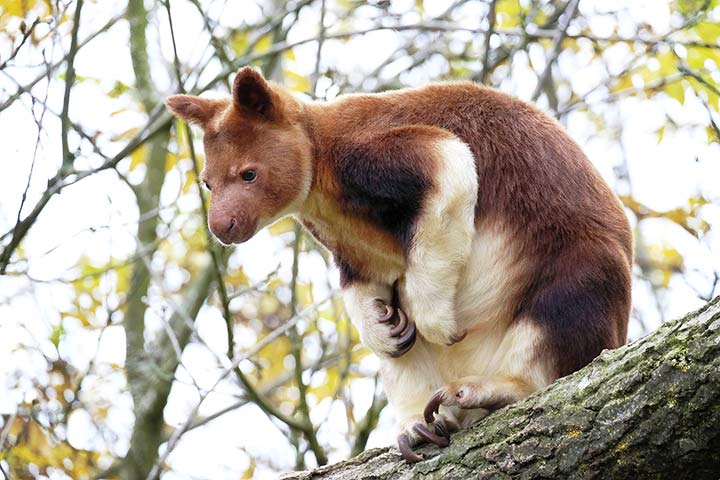
Senses and Abilities
Locomotion
Tree kangaroos can move all four limbs independently. This is a big difference from ground-dwelling kangaroos, which can only hop on their two hind legs.
Climbing
Tree kangaroos are excellent climbers. They can easily hold on to tree bark with their long claws. They also have cushioned pads on their paws, which help them get a better grip. Their feet are wide and aid in maintaining stability, too. The long tail they have is like a weight that helps them balance even more.
Jumping
Tree kangaroos can jump remarkably far. When they jump from tree to tree, they cover distances of up to 30 feet (9 meters). It is said that they can even jump down from a tree at a depth of 60 feet (18 meters).
Running
Tree kangaroos are also capable of walking on the ground, although their movements are quite slow and awkward in that environment. Running becomes difficult for them because their long and hefty tail frequently acts as an obstacle.
Communication
Tree kangaroos are very calm and quiet. They communicate with their peers primarily through their body language and smells.
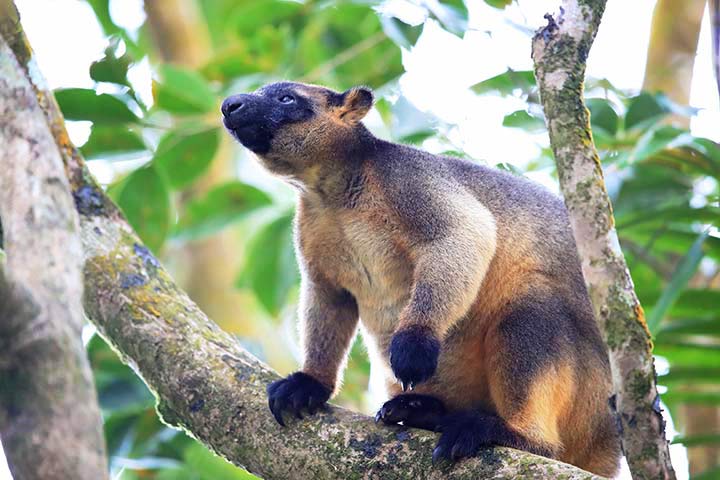
Life Expectancy
Tree kangaroos can live 15-20 years. The oldest in the world was Patty and a Matschie tree kangaroo. She was 27 years old.
Enemies and Threats
Natural Enemies
Tree kangaroos have few natural enemies. They're sometimes surprised by big snakes such as the New Guinea amethystine python. Dingoes also pose a threat.
Humans
Humans are the biggest threat to tree kangaroos.
• Destruction of Habitat
Tree kangaroos are facing a constant decrease in their habitat. Every day, more trees are cut down for timber, coffee plantations are expanding, and agricultural activities like rice and wheat cultivation are encroaching on their homes. Over the past three decades, a staggering 90% of their habitat has been lost.
• Hunting and Poaching
The indigenous peoples of Papua New Guinea hunt the animals for their meat and beautiful fur. Sometimes they're caught and sold as pets.
• How Many Tree Kangaroos Are Left?
In the last 30 years the number of animals has decreased by 80%. According to the IUCN, in 2016 there were still around 2,500 animals of the Matschie's tree kangaroo (as of February 2024, no newer data available). It is estimated that there are 55 Goodfellow tree kangaroos remaining, making them critically endangered. The population numbers of the other species are quite low, too, ranging between 100-500. However, the Lumholtz's and Bennett's tree kangaroos are the only ones that aren't classified as endangered species yet.
• Almost Extinct
The Wondiwoi tree kangaroo has been thought to be extinct for 90 years. However, in 2018 there was a big surprise: A Wondiwoi was probably catched in a photograph. Unfortunately, if it really was a Wondiwoi couldn't be confirmed for sure, because the quality of the photo was very poor.
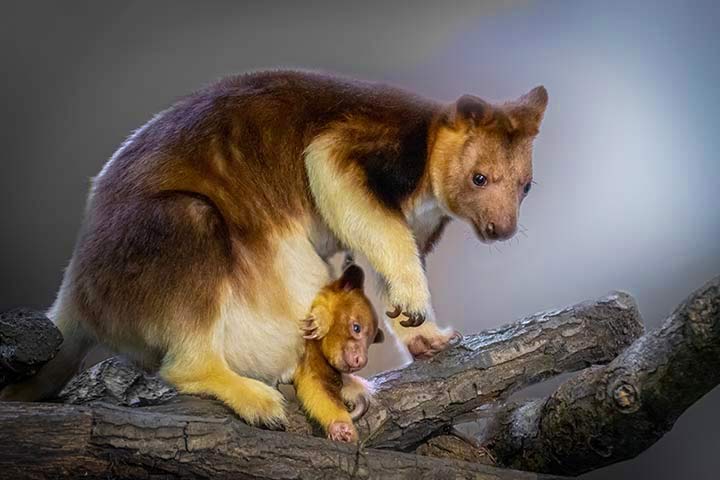
Reproduction
Mating Ritual
In the Matschie's tree kangaroos, females and males touch each other's noses and click their tongues to show each other their affection.
Gestation Period
Of all marsupials, tree kangaroos have the longest gestation period, lasting only 44 days. When born, the baby is less than one inch (2 cm) in size. It quickly crawls into its mother's pouch, latches onto a teat, and starts nursing. After five to six months it is sticking its head out of the pouch for the first time. When it is seven months old, it leaves the pouch and begins to take its first steps. After 10-12 months the cub is independent and begins to explore the world on its own.
Fun Facts
Tree Rabbit
The scientific name “Dendrolagus” is a Greek word. It is made up of “Dendro” for “tree” and “Lagus” for “rabbit”. Consequently, its name means “tree hare”.
The Tree Kangaroo Is Related To:
- Red Kangaroo
- Wallaby
Animals in the Same Biome:
- Cat
- Crocodile
- Crowned Pigeon
- Echidna
- Dingo
- Dog
- Fox
- Fruit Bat
- Gecko
- Hornbill
- Laughing Kookaburra
- Microbat
- Snakes
- Southern Cassowary














